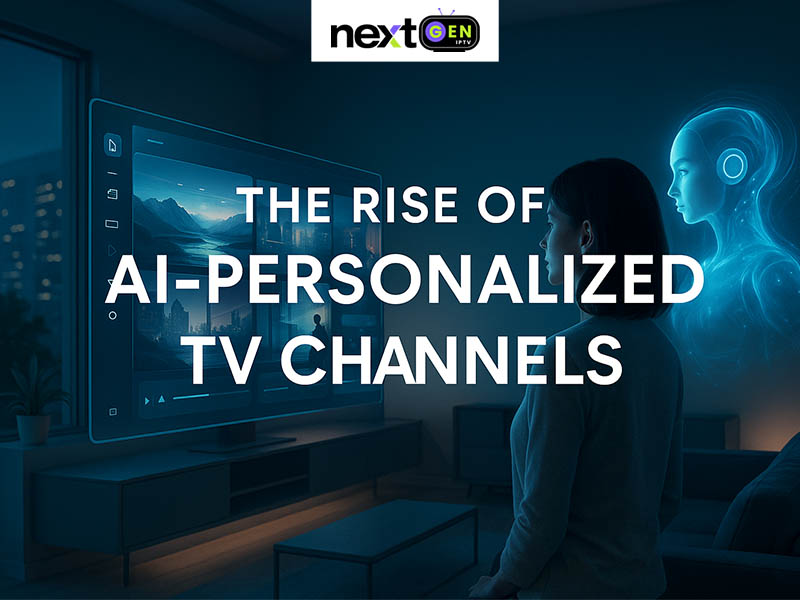- Instant Activation
- 24x7 Support
- Free Shipping
- 315-856-9032

The Rise of AI-Personalized TV Channels
Television changed a lot over the years. It started as scheduled programs on big screens. Then came cable, offering many channels. Now, people turn to streaming. One of the biggest changes in this shift comes from AI—artificial intelligence. It does more than suggest what to watch. It builds channels around the viewer. The content feels made just for the person watching. This kind of smart TV is becoming common, and it’s changing how entertainment works.
What Are AI-Powered IPTV Channels?
AI-powered IPTV channels use machine learning to build a stream of content based on habits. These channels don’t follow fixed schedules. They react to the user. The system picks shows and movies by learning what the person likes. Instead of flipping through channels, the viewer sees content that feels chosen just for them. This makes the whole experience smoother and more personal. Platforms like YouTube, Netflix, and others already use this model in different ways.
How AI Is Changing TV Channels
Traditional channels show the same thing to everyone. AI doesn’t. It watches what people click, how long they watch, and what they skip. Then it uses that information to build a custom playlist. That list keeps changing based on new choices. The more someone watches, the better AI understands what works. This way, people waste less time searching. Shows start quicker, and there’s less guessing.
AI Personalization in Streaming Services
Streaming services use AI to improve every part of the viewing experience. AI changes thumbnails to match the viewer’s interests. It pushes certain titles to the front of the home screen. It suggests what to watch next before the credits roll. AI also adjusts recommendations by time of day or device type. Someone watching late at night might see different picks than during the day. All these actions happen quietly in the background, without asking the viewer to do anything.
Machine Learning in TV Content Recommendations
Machine learning forms the brain behind most AI systems. It gathers data—what’s played, paused, rewound, or skipped. Then it looks for patterns. For example, if someone watches a lot of crime shows, the system starts offering more of that type. If a person tends to watch short videos, it avoids long movies. The machine learns over time. That’s what makes the channel feel smarter each day.
How AI Decides What You Watch Next
AI doesn’t guess. It calculates. It looks at titles that other similar users watch. It checks viewing time. It compares genres and themes. Then it lines up the next show. This choice doesn’t just depend on one click—it’s built from many actions over time. The viewer might not notice how the system makes the choice, but the match often feels right. That’s how AI keeps the viewer watching longer without frustration.
Are AI-Personalized Channels Better Than Cable?
Many viewers now say yes. Cable follows a fixed path. Shows air at set times. If something’s missed, waiting or recording becomes the only option. AI-personalized channels let viewers press play any time. The content already fits their taste. There’s no need to sit through ads or skip past unwanted programs. That freedom and comfort appeal to people who want control. Still, some miss the surprise of regular TV. But overall, people move toward control over routine.
Benefits of AI in Digital Media Platforms
The main benefit is time. AI helps viewers spend less time looking and more time watching. It also improves satisfaction. People enjoy what they see more often. That boosts return visits to the platform. It helps platforms understand content value better too. If certain content keeps viewers around, the platform can invest in more of it. AI helps both the viewer and the service grow smarter together.
Future of AI in Media and Entertainment
AI won’t stop at picking shows. It’s already working on scripts, dubbing, and even video editing. In the future, live channels might adjust in real time to viewer mood or engagement. Voice AI may answer viewer questions or suggest behind-the-scenes extras. Some systems will even create dynamic content based on personal history or recent viewing trends. Entertainment will grow more interactive, and much of that change will come from AI behind the screen.
How Artificial Intelligence Is Shaping Viewer Habits
People watch faster now. They binge more. They switch between genres easily. AI plays a part in that. It suggests content that fits current moods. It fills breaks with quick picks. AI removes much of the old friction in TV watching. Over time, habits shape around convenience, speed, and relevance. Viewers don’t wait for good content. It finds them.
The Rise of Artificial Intelligence in Daily Life
AI doesn’t just live in screens. It runs inside phones, homes, and cars. It answers questions, sorts photos, and suggests meals. In that bigger picture, TV is just one part. Still, it’s a major one. People spend hours each day watching something. When AI shapes that experience, it shapes part of the day. That makes it personal, even if the tech runs quietly in the background.
Conclusion
AI-personalized TV channels grow from simple tools into daily helpers. They take old ideas—like scheduled programming—and turn them into something flexible and personal. The shift feels natural to most viewers. Watching becomes easier, smoother, and often more fun. The rise of AI in entertainment feels steady, not sudden. Still, it brings a clear change. One where the screen listens and learns, instead of just playing. That shift will keep shaping how people watch, one viewer at a time.
